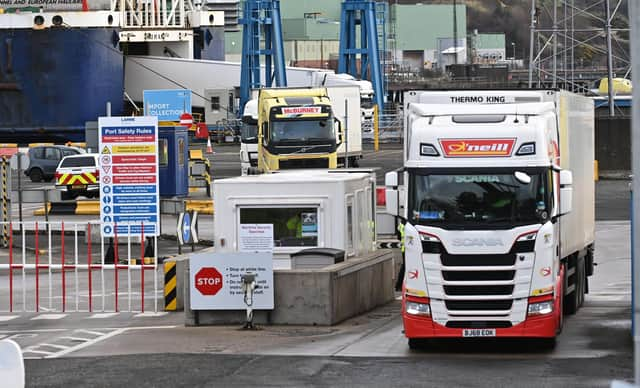Analysis: How green is the Green Lane for goods under the Windsor Framework? There are situations in which it could fade or become blotchy


The Windsor Framework eases many of the Protocol-based requirements for moving goods into Northern Ireland from elsewhere in the United Kingdom. A green lane has been agreed and is being implemented. It is, however, limited to certain goods that are expected to and essentially will remain in NI. And to this end, traders have to be trusted to comply with requirements and the UK government has to demonstrate that it can be trusted by the European Union (EU) to implement what has been agreed. With the apparent return of trust to post-Brexit UK-EU relations, the outlook is currently positive. If the situation changes, the greenness of the green lane may, however, fade; this is one to watch.
In the Windsor Framework announced earlier this year, the UK and the EU agreed to lift or ease a range of post-Brexit restrictions on the movement of goods from GB to NI and to do so on the basis of legal clarity and certainty rather than the uncertainty of the ‘grace periods’. Agreement was reached on establishing what the UK government likes to refer to as a ‘green lane’ system for goods moving from Great Britain into Northern Ireland and, importantly, remaining there. Its operation is being phased in from October 2023.
Easing the Movement of Goods


Advertisement
Hide AdAdvertisement
Hide AdAlthough the UK Government announced that the green lane ‘removes any sense of a border in the Irish Sea’, such a claim is generally treated with some scepticism. The focus of what the UK and the EU have agreed is a reduction in formalities associated with the movement of certain goods. The UK Government chose its words carefully in its Windsor Framework Command Paper: ‘goods being sold in Northern Ireland will be freed of unnecessary paperwork, checks and duties’ (emphasis added).
This is not to deny the significance of the Windsor Framework for easing the formal requirements for the GB-NI movement of goods. Major changes regarding the implementation of the Protocol on Ireland/Northern Ireland have been agreed and many goods can now move more freely than would have been the case with the Protocol’s full implementation. Subject to labelling and data-sharing requirements, certification requirements for retail goods have been eased as have requirements for the movement of certain plants, seed potatoes and agricultural machinery where some bans and controls have also been removed.
On customs, the EU-UK Joint Committee has agreed that goods for use in animal feed, healthcare provision, not-for-profit activities, and construction in NI, are now all exempt from customs duties; additionally the annual turnover threshold for an NI business to be exempt from any customs duties due on goods coming from GB has been raised from £0.5m to £2.0m. EU legislation adopted at the end of May 2023 to implement Windsor Framework commitments will also see new and innovative human medicines being accepted for use in NI on the basis of UK authorisations and certification requirements for the GB-NI movement of pets eased. As the EU noted when adopting the new legislation, ‘[t]he new rules will make it considerably easier to move a range of goods from Great Britain into Northern Ireland’ (emphasis added), adding ‘if they are destined for final consumption there’.
The language describing the effects of the ‘green lane’ is carefully chosen, and begs the question: how green is the ‘green lane’? Being free of ‘unnecessary’ paperwork, checks and duties suggests some necessary paperwork, checks and duties remain; making movements ‘easier’ suggests that restrictions still exist.


Five Observations on the ‘Green Lane’
Advertisement
Hide AdAdvertisement
Hide AdA first observation is that the ‘green lane’ addresses two specific sets of issues: customs rules and checks from October 2024, and the movement of agri-food goods subject to EU sanitary and phytosanitary (SPS) rules and checks from the earlier date of October 2023. In both cases the ‘green lane’ only applies ‘where the goods are destined for final consumption or final use in Northern Ireland’ and so not moving on across the border into Ireland and the EU internal market. Goods not for final consumption in Northern Ireland must go through a ‘red lane’ in which all requirements under the Protocol will apply. With the green and red lanes, the ‘grace period’ arrangements cease.
Second, the green lane does not actually remove customs formalities for GB goods remaining in NI, it simplifies them. It does not remove regulatory – essentially SPS – compliance obligations for GB retail goods remaining in NI; rather, it eases them. Regulatory easements in the green lane do not therefore exist for all types of retail goods. The focus is on those goods with the most onerous SPS compliance obligations and covers pre-packaged products of animal or plant origin (e.g. fresh meat, fresh vegetables), food and food contact goods (e.g. food packaging, cutlery, kitchen equipment), plants (other than for planting) and pet food as well as composite food products (e.g. ready-made meals/ sandwiches).
Indeed, the green lane involves the non-application of only around 65 of the approximately 300 EU acts that otherwise apply to goods being moved into NI under Article 5 and Annex 2 of the Protocol. In many cases EU acts that continue to apply cover the same policy area as acts that will not apply. As Table 1 indicates, for example, of the eight EU acts under the sub-heading ‘goods – general provisions’ six will continue to apply to GB goods moving into Northern Ireland via the green lane but two will not apply; similarly of the 23 EU acts listed under ‘food – ingredients, traces, residues, marketing’ three will continue to apply to green lane goods but 20 will not apply. Importantly all of the c300 EU acts continue to apply to general goods production in Northern Ireland.
Third, there is the question of who can use the green lane? The answer: a ‘listed establishment’ more commonly known as a ‘trusted trader’ or ‘authorised operator’. Details of how a trader can become a ‘listed establishment’ were announced by the UK government in June/July 2023.
Advertisement
Hide AdAdvertisement
Hide AdTraders will need to be registered on the Northern Ireland Retail Movement Scheme (NIRMS) for SPS goods and the UK Internal Market Scheme (UKIMS) for goods generally. The former will replace the Scheme for Temporary Agri-food Movements to Northern Ireland (STAMNI) and the latter the UK Trader Scheme (UKTS) both of which have been in operation since the Protocol came into effect on 1 January 2021. Changes to the qualifying thresholds and the application processes for the new systems should make it easier for more operators to become ‘authorised’ and be able to use the green lane. For example, under the UKTS, only Northern Ireland-based businesses could become authorised traders; now, UKIMS authorisation is open to GB-based businesses provided they have some form of customs representation in NI. There are also due to be dedicated processes for transit companies and parcel carriers to become ‘authorised’ operators and so deliver parcels to consumers in NI without checks and customs declarations as otherwise required under the Protocol. The EU adopted relevant legislation in June 2023; the UK government is due to announce further details of the arrangements by the end of 2023.
A fourth observation is that although the green lane removes, for traders, ‘unnecessary’ paperwork and checks it still requires some paperwork and some checks. For example, instead of each good in a supermarket consignment requiring an individual certificate to enter Northern Ireland, consignments of food will now be covered by one ‘General Certificate’ containing details of who is sending, receiving and transporting the goods, the place of dispatch and destination, the means of transport the and proposed point of entry into Northern Ireland. The consignment will need to be sealed with a unique number and be accompanied by a Common Health Entry Document (CHED). As for checks, these will no longer be routine but ‘risk-based’ and ‘intelligence-led’.
Moreover, in exchange for the reduced formalities, the EU requires ‘Not for EU’ labelling to be phased in for agri-food products entering Northern Ireland through the green lane. Meat and fresh dairy products are to be labelled from October 2023, all other dairy products from October 2024, and composite products, fruit, vegetables and fish from July 2025.
Fifth, there is the question of whether the green of the green lane is a permanent green. This will depend on whether the extensive data-sharing, labelling and market surveillance requirements underpinning the operation of the green lane are fully implemented.
Advertisement
Hide AdAdvertisement
Hide AdIf the European Commission believes that the UK is failing to fulfil its commitments and obligations, and initiates consultations with the UK government which do not produce a ‘remedy’ within four weeks, aspects of the green lane will cease to apply within the next four week period. The green will fade or become blotchy.
Green Lane or Red Lane?
The fact that the ‘green lane’ is not as green as the description suggests was effectively acknowledged in evidence given by the UK Foreign Secretary, James Cleverly, to the House of Lords. His focus was on the UK government having ‘massively simplified the bureaucracy around east-west trade from GB to NI’. He added, ‘That is not to say it is perfect, and that is not to say there will not be frustrations at some points’.
Frustration has already been voiced at the limitations for and requirements associated with using the green lane and the fact that some requirements are self-evidently more burdensome than practice to date with the ‘grace periods’. There are also frustrations that lorries carrying mixed loads (‘groupage’) – i.e. loads containing a mix of goods eligible for the green lane and those that need to go through the red lane – must enter Northern Ireland using the red lane, although the goods eligible for the green lane will only require certification etc. for the green lane. On the positive side, however, the Windsor Framework brings with it the legal clarity and certainty that businesses in NI have generally been seeking since 2021.
How much the green lane will be used remains to be seen. Retailers, especially the supermarkets, seem set to be the largest users; manufacturers in Northern Ireland appear more likely to use the red lane so that the goods can be shown to comply with applicable EU law and so be processed and sold on into the EU market.
Advertisement
Hide AdAdvertisement
Hide AdSome traders have questioned the costs associated with meeting the green lane requirements and fear that some smaller suppliers elsewhere in the UK will simply no longer supply the Northern Ireland market.
Hauliers are particularly concerned about the arrangements. Only time and implementation will reveal the value of the Windsor Framework in facilitating GB-NI movements of goods under the Protocol and whether the ‘green lane’ lives up to the UK government’s initial sales pitch.
l Professor David Phinnemore and Dr Lisa Claire Whitten are both members of the Post-Brexit Governance NI project, funded by the Economic and Social Research Council and based at Queen's University Belfast. This article has been produced as part of the project and originally appeared on the Queen’s Policy Engagement blog